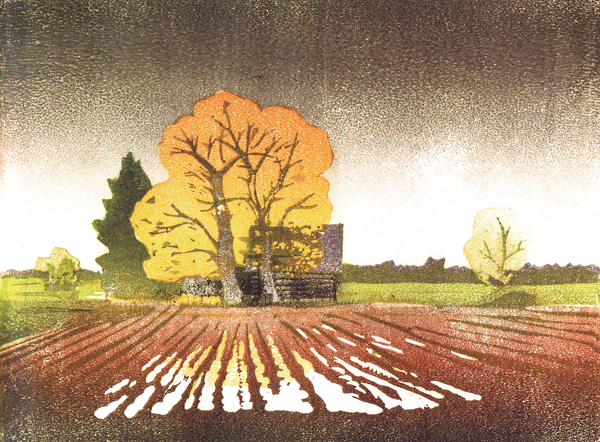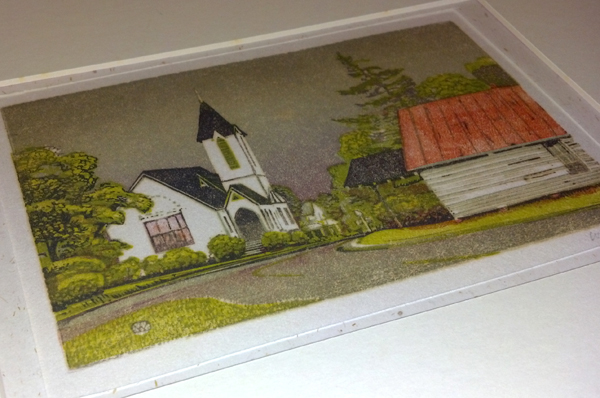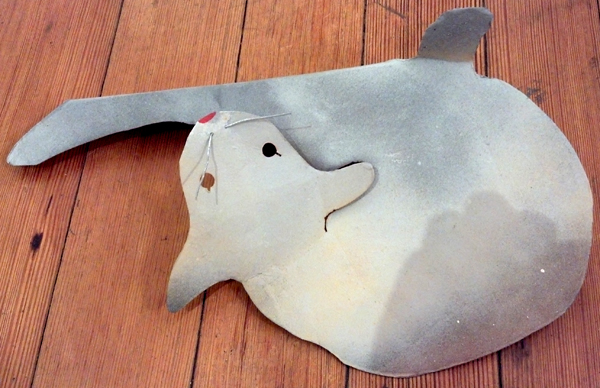
A retrospective look at Georgia watercolorist’s work as printmaker, sculptor
An exciting exhibit of block prints and tin sculptures goes on display at The Gallery at Macon Arts Alliance, a Knight Arts grantee, this week. “When East Meets South” is a retrospective featuring the work of retired physician Dr. Roy Ward, of Watkinsville, Georgia. Though Ward has been an artist for many decades — his watercolors and drawings were displayed at the Museum of Arts and Sciences in Macon as early as 1973 — his block prints have not garnered the public acclaim of his other work. This exhibit, curated by Heatherly Wakefield, director of fine art at Macon Arts Alliance, seeks to shine a light on the lesser known aspects of Ward’s oeuvre.
Now in his early 90s, Ward hopes to bring attention to his work as a printmaker. In 2004, he published a catalog chronicling his study and craft in the tradition of Japanese block printing, “From Chickens to Poinsettas,” which includes an account of his first trip of Japan.
Ward wrote,
” Many years later, in midlife, depressed by my failure to become what I would have wished to become, I determined to live and work on and save enough money to visit Japan. I went alone, with no set date for return… The places which thrilled me were many indeed, and the places in which I felt the most comfort, in which I recognized the most companionship, were the rock and sand and moss gardens. I have never since then felt as lonely as I once did.”
After this life-changing exposure to Japan and the art of Japanese block printing, Ward began to create compositions based on antique Japanese illustrations.
“It gave me great respect for the precise cutting which those artisans could do with their cherry wood blocks, and for the unequaled skill with which they carried out their entire process,” he wrote. “Japanese block prints have never been, and will never be, equaled.”
A church and building, characteristic of rural Georgia in the mid-20th century, are depicted in this print by Ward.
So Ward created work which was characteristically Japanese in technique, and which derived its inspiration from masters like Hokusai. Where he diverged, and what makes his work so compelling, is in the subject matter he chose to portray. As a rural doctor, Ward is among the last generation of physicians to make regular house calls. His travels took him across the scenic countryside of Georgia, and between stops, he would make sketches of what he saw. Back in his studio, he would carve and print compositions depicting the landscapes of his daily life using the techniques he had developed through years of study.
Now, in what the doctor refers to as the end of his creative life, his work has diverged again. Along with a significant amount of block prints created by Ward, his latest series of sculptures of tin cats will also be on display. Just as Henri Matisse began making paper cutouts late in his career, Dr. Ward has begun making cutouts in tin, returning to another favorite subject of his early watercolors — the house cat.
As he became physically unable to carve block prints, Ward began making sculptures using tin cutouts, harkening back to the Fauvist Henri Matisse, who was also influenced by the aesthetics of Japanese art.
As an artist, Ward only hopes that he will see his work garner the attention it deserves, especially since he has ceased to create much new work.
“My block prints have never had serious recognition. I can never make any more, and it is impossible to expect anyone else to duplicate my work from my original blocks. Each print was hand made with considerable variations,” he explained.
“When East Meets South” will be on display July 6-28 with an opening reception July 6 from 5-8 p.m.
The Gallery at Macon Arts Alliance, 486 First St.; Macon; 478-743-6940; www.maconartsalliance.org
Recent Content
-
Artsarticle ·
-
Artsarticle ·
-
Artsarticle ·



